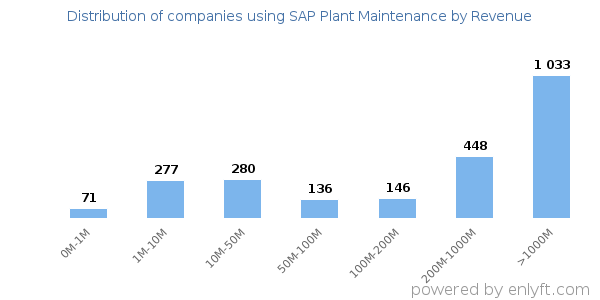Companies using SAP Plant Maintenance
We have data on 2,299 companies that use SAP Plant Maintenance. The companies using SAP Plant Maintenance are most often found in United States and in the Information Technology and Services industry. SAP Plant Maintenance is most often used by companies with >10000 employees and >1000M dollars in revenue. Our data for SAP Plant Maintenance usage goes back as far as 9 years and 4 months.
Who uses SAP Plant Maintenance?
| Company | Mohawk Industries, Inc. |
| Website | mohawkind.com |
| Country | United States |
| Revenue | >1000M |
| Company Size | >10000 |
| Company | EPAM Systems Inc |
| Website | epam.com |
| Country | United States |
| Revenue | >1000M |
| Company Size | >10000 |
| Company | SAP SE |
| Website | sap.com |
| Country | United States |
| Revenue | >1000M |
| Company Size | >10000 |
| Company | Accenture PLC |
| Website | accenture.com |
| Country | Ireland |
| Revenue | >1000M |
| Company Size | >10000 |
| Company | Cognizant Technology Solutions Corp |
| Website | cognizant.com |
| Country | United States |
| Revenue | >1000M |
| Company Size | >10000 |
| Company | Website | Country | Revenue | Company Size |
|---|---|---|---|---|
| Mohawk Industries, Inc. | mohawkind.com | United States | >1000M | >10000 |
| EPAM Systems Inc | epam.com | United States | >1000M | >10000 |
| SAP SE | sap.com | United States | >1000M | >10000 |
| Accenture PLC | accenture.com | Ireland | >1000M | >10000 |
| Cognizant Technology Solutions Corp | cognizant.com | United States | >1000M | >10000 |
Target SAP Plant Maintenance customers to accomplish your sales and marketing goals.
SAP Plant Maintenance Market Share and Competitors in Enterprise Resource Planning (ERP)
We use the best indexing techniques combined with advanced data science to monitor the market share of over 15,000 technology products, including Enterprise Resource Planning (ERP). By scanning billions of public documents, we are able to collect deep insights on every company, with over 100 data fields per company at an average. In the Enterprise Resource Planning (ERP) category, SAP Plant Maintenance has a market share of about 0.2%. Other major and competing products in this category include:
Enterprise Resource Planning (ERP)
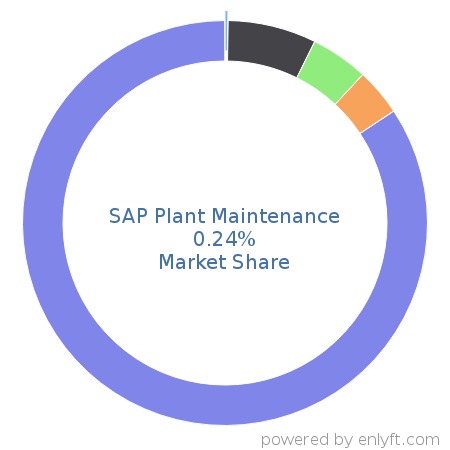

What is SAP Plant Maintenance?
SAP PM (Plant Maintenance) is a functional module which handles the maintaining of equipment's and Enables efficient planning of production and generation schedules and provides interfaces to process control and SCADA systems. The R/3 Plant Maintenance (PM) application component provides one with a comprehensive software solution for all maintenance activities that are performed within a company. Supports cost-efficient maintenance methods, such as risk-based maintenance or preventive maintenance, and provides comprehensive outage planning and powerful work order management.
Top Industries that use SAP Plant Maintenance
Looking at SAP Plant Maintenance customers by industry, we find that Information Technology and Services (15%), Oil & Energy (8%) and Chemicals (6%) are the largest segments.
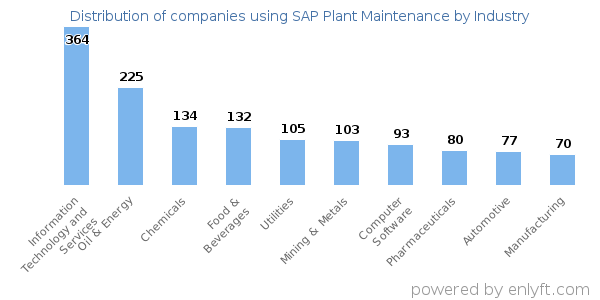
Top Countries that use SAP Plant Maintenance
41% of SAP Plant Maintenance customers are in United States, 9% are in India and 6% are in Canada.
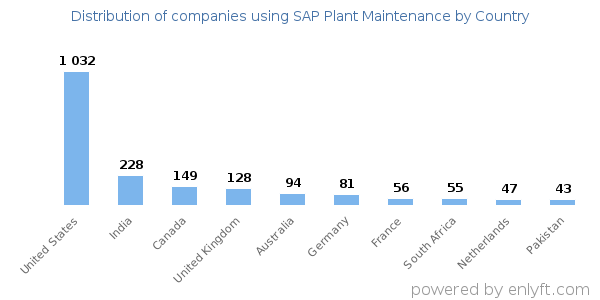
Distribution of companies that use SAP Plant Maintenance based on company size (Employees)
Of all the customers that are using SAP Plant Maintenance, a majority (55%) are large (>1000 employees), 14% are small (<50 employees) and 29% are medium-sized.
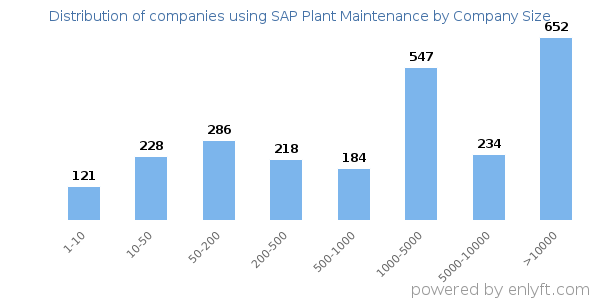
Distribution of companies that use SAP Plant Maintenance based on company size (Revenue)
Of all the customers that are using SAP Plant Maintenance, a majority (58%) are large (>$1000M), 25% are small (<$50M) and 13% are medium-sized.
